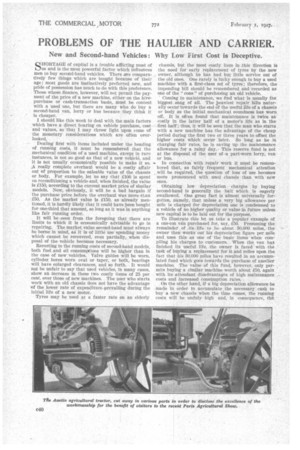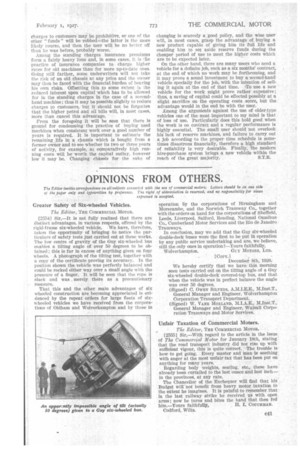PROBLEMS OF THE HAULIER AND CARRIER.
Page 62

Page 63

If you've noticed an error in this article please click here to report it so we can fix it.
New and Second-hand Vehicles: Why Low First Cost is Deceptive.
SHORTAGE of capital is a trouble afflicting most of us and is the most powerful factor which influences men to buy second-hand vehicles. There ave comparatively few things which are bought because of their age; most goods are instinctively preferred new, and pride of possession has much to do with this preference. Those whose finance, however, will not permit the payment of the price of a new machine, either on the hirepurchase or cash-transaction basis, must be content with a used one, but there are many who do buy a second-hand van, lorry or bus because they think it is cheaper.
I should like this week to deal with the main factors which have a direct bearing on vehicle purchase, cost and values, so that I may throw light upon some of the monetary considerations which are often overlooked.
Dealing first with items included under the heading of running costs, it must be remembered that the mechanical condition of a used machine, except in rare instances, is not so good as that of a new vehicle, and it is not usually economically possible to make it so. It really complete overhaul would be a costly affair out Of proportion to the saleable value of the chassis or body. For example, let us say 'that £100 is spent on reconditioning a vehicle and, when finished, the value Is £150, according to the current market price of similar models. Now, obviously, it will be a bad bargain if the purchase price before the overhaul was more-than 150. As the market value is £150, as 'already mentioned, it is hardly likely that it could have peen bought for one-third that amount, so long as it was in anything like fair running order.
It will be -seen from the foregoing that there are limits to which it is economically advisable to go in repairing. The market value second-hand must always be borne in mind, as it is of little use spending money which cannot be recovered, even partially, when disposal of the vehicle becomes necessary.
Reverting to the running costs of second-hand models, both fuel and oil consumptions will be higher than in the case of new .vehicles. Valve guides will be worn, cylinder bores worn oval or taper, or both, bearings will have enlarged clearances, and so forth. It would not be unfair to say that used vehicles, in many cases, show an increase in these two costly items of 25 per cent, over those of new machines. The user who starts work with an old chassis does not have the advantage -of the lower rate of expenditure-prevailing during the initial life of a new motor.
Tyres may be used at a faster rate on an elderly chassis, but the most costly item in this direction is the need for early replacement of tyres by the new , owner, although he has had but little service out of the old ones. One rarely is lucky enough to buy a used machine with a first-class set of tyres ; therefore, the impending bill should be remembered and recorded as one of the " cons " of purchasing an old vehicle.
Coining to maintenance, we find what • is usually the biggest snag of all. The Zeaviest repair bills naturally occur towards the end of the useful life of a chassis or body as the initial mechanical soundness has worn off. It is often found that maintenance is twice as costly in the latter half of a motor's life as in the first half ; thus, it will be seen that the man who starts with a new machine has the advantage of the cheap period during the first two or three years to offset the higher costs which occur later. So long as he is charging fair rates, he is saving up the maintenance allowance for a rainy day.. This reserve fund is not at the disposal of the user of a part-worn lorry, van or bus.
In connection with repair work it must be remembered that, as fairly frequent mechanical attention will be required, the question of loss of use becomes more pronounced with used chassis than with new ones.
Obtaining low depreciation charges by buying second-hand is generally the bait which is eagerly swallowed. One great fact is almost universally forgotten, namely, that unless a very big allowance per mile is charged for depreciation one is condemned to a vehicle of no higher quality or value in future unless new capital is to be laid out for the purpose.
To illustrate this let us take a popular example of a one-ton van purchased for, say, £50. Presuming the remainder of its .life to be about 30,000 miles, the owner then works out his depreciation figure per mile and_ uses this as one of the basic Items when compiling his charges to customers, When the van haF finished its useful life, the owner is faced with the task of buying a replacement for it and relies upon the fact that his 30.000 miles have resulted in an accumulated fund which goes towards the purchase of another machine. The value of this fund, however, only permits buying a similar machine worth about £50, again with its attendant disadvantages of high maintenance — costs and increased consumption rates.
On the other hand, if a big depreciation allowance be made in order to accumulate_ the necessary cash to buy a new chassis when the time comes, the running costs will be unduly high and, in consequence, thd charges to customers may be prohibitive, or one of the other " funds " will be -robbed—the latter is the more likely 'course, and then the user will be no better off than he was before, probably worse.
Among the standing charges insurance premiums form a fairly heavy item and, in some cases, it is the practice of insurance companies to charge higher rates for old machines than for more up-to-date ones. Going still farther, some underwriters will not take the risk of an old chassis at any price and the owner may then be faced with the financial burden of bearing his own risks. Offsetting this to some extent is the reduced interest upon capital which has to be allowed for in the Standing charges in the case of a secondhand machine; thus it may be possible slightly to reduce charges to customers, but it should not be forgotten that the higher petrol and oil bills will, in most eases, more than cancel this advantage.
From the foregoing it will be seen that there is ground for condemning the practice of buying used machines when consistent work over a good number of years is required. It is important to estimate the remaining life in a chassis which is bought from a former owner and to see whether its two or three years of activity, for example, at comparatively high running costs will be worth the capital outlay, however low it may be. Changing chassis for the sake of
changing is scarcely a good policy, and the wise user will, in most cases, grasp the advantage of buying a new product capable of giving him its full life and enabling him to set aside reserve funds during the cheaper period of use to meet the higher costs which are to be expected later.
On the other hand, there are many users who need a vehicle for a definite job, such as a six months' contract, at the end of which no work may be forthcoming, and it may prove a sound investment to buy a second-hand vehicle specially for the job, with the intention of selling it again at the end of that time. 'To use a new vehicle for the work might prove rather expensive; thus, a saving of capital could be effected possibly at a slight sacrifice on the operating costs score, but the advantage would in the end be with the user.
Among the arguments against the use of older-type vehicles one of the most important to my mind is that of loss of use. Particularly does this hold good when the work is on contract and a regular performance is highly essential. The small user should not overlook his' lack of reserve machines, and failure to carry out a job according to the proper time schedule is sometimes disastrous financially, therefore a high standard of reliability is very desirable. Finally, the modern hire-purchase system brings a new vehicle within the reach of the great majority. S.T.R.


































































































